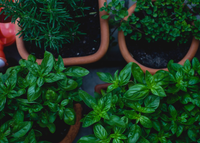Whether dried or fresh, herbs are a kitchen staple
Herbs make for a fantastic garnish and have tremendous health benefits, but they’re also some of the most pesticide-sprayed crops you’ll find in the grocery store. Thankfully, they are some of the easiest plants to start in your garden, they store successfully over winter, and when home-grown make an impressive environmental and humanitarian impact.
Conventionally grown herbs
The increased use of pesticides and herbicides in agriculture goes beyond the “Dirty Dozen” crops and has seeped into the herbal world. Most herbs have a low natural shelf life, which makes them susceptible to commercial processes (like spraying) that increases their shipping capabilities and extends their grocery-store presentation.
Based on USDA data, cilantro has the highest pesticide use and is neck and neck with two on the Dirty Dozen list: spinach and kale. The most frequently detected pesticide on cilantro is DCPA (Dacthal) which is classified as a possible human carcinogen, and imidacloprid has been found on basil, which is a common bee-killing neonicotinoid pesticide.
Insecticides and pesticides are harmful to insect and pollinator populations, while also being a detriment to soil and human health. If you’re not growing your own herbs, buying locally grown (non-sprayed) and organic herbs are the best alternatives.
Exploitive labour for dried herbs and spices
Though it’s not always possible to buy fair trade in higher-cost products, herbs and spices should be high on the list if you’re able. Once you begin drying and grinding your own herbs, you’ll notice the high-intensity labour that goes into the process. When looking at herbs priced under a dollar, and considering that a wage, shipping costs and grocery store costs are factored into that, an alarm bell should be going off in your head.
Most of these low costs are at the expense of humans on the other end of the process who experience a power imbalance with their employers, work in poor conditions for their health and well-being, and are often minors and children who don’t have a say in the matter. According to the Bureau of International Labor Affairs from the U.S. Department of Labor, cumin is still produced by child labour in Turkey, where most of our teas come from the same child labour though in Kenya, Uganda, Vietnam and beyond.
Again, if you’re unable to grow your own herbs, buying Fairtrade ensures that the cost of sustainable production is covered for the small farm, plus a livable wage for the employees and workers.
 Photo by Markus Spiske on UnsplashHow to best harvest your herbs for drying or freezing
Photo by Markus Spiske on UnsplashHow to best harvest your herbs for drying or freezing
If you are going to try your hand at drying or freezing your herbs for winter, this part is for you. It’s fairly easy and will help you preserve that garden-fresh herb taste when gardening season is long over.
1. Harvest
- Harvest before your plant goes to flower for the best flavour.
- Cut back branches before the hot afternoon sun.
- Only cut two-thirds of the plant at one time to allow it to recover.
- Check for bugs. They like to wiggle their way onto leaves.
2. Hanging to dry
- Thinly bundle herbs and hang them in a cool, dry location and place a paper bag around the stems with an elastic. Make sure the bag has holes in it for air circulation. Check back after 5 to 7 days and see if you can crumble any into the bag; if not, you can let it hang for longer. You can also hang herbs without the bag, but you may have a crumbly mess on the ground.
- Crumble the herbs into the bag or use a mortar and pestle to thinly grind them.
- Transfer into an airtight jar and store in a cool, dark location for up to a year*.
3. Dehydrating to dry
- Place herbs flat in one layer on the dehydrator (do not bundle or place herbs in clumps on top of one another).
- Set to the necessary temperature based on the given recipe or your dehydrator’s strength. Normally herbs are dried at 95 to 115 F, but if you have a humid house or are dehydrating herbs with high water content, you may go up to 125 F.
- Crumble the herbs in a mortar and pestle.
- Transfer into an airtight jar and store in a cool, dark location for up to a year*.
- Avoid using the oven unless it’s your only option. The oven can cook the herbs and extract a lot of the delicious flavour.
Best herbs to dry: Bay leaf, dill, marjoram, oregano, rosemary, summer savory and thyme
4. Freezing for storage
Yes, you can absolutely freeze your fresh herbs. The best herbs to freeze are those with a higher water content like basil, chives, mint and tarragon.
- Cut herbs into strips and place them onto a tray into the freezer.
- Once frozen, place them into an airtight bag.
- You can also pack herbs into ice cube trays, pour water over them, and freeze herb cubes for soups and stews.
Between freezing and drying, these are wonderful and accessible ways to use homegrown herbs all winter long without worrying about the environmental or human impact of the crops, while also savouring that fresh from-the-garden taste for longer.
*They’re absolutely still good after a year, they just lose their flavour!

